part four of a six part series of an INSTRUCTIONAL nature regarding tsww [the second world war- diffraction games] using the singapore module. parts one, two, and three are in the bold links.
March I 1942 Turn
Weather rolls are 8 and 4. This means the weather is Hot in both zones, and Good in the Tropical Monsoon Zone and Poor in the Monsoon South zone (which includes the area around Soerabaja). We’ll try to remember that.
Japanese Initial Phase
Japan performs activities listed in order of play. Per special rule, all land-based air units are considered in supply, and the ground forces on ships are in offensive and general supply until they land. So no real supply issues; and Allied forces are not isolated. Japanese reinforcements arrive per scenario. Betties in Borneo and a further 2CA/2DD and 1CL/3DD force in the East. Japan also rolls for NIM — National Intelligence Means — Spotting. This reflects breaking of naval codes and other such intelligence. Japan rolls with +2 (for early ’42). It fails on a roll of 5.
Both players also assign air to naval cooperation, CAP, and gunnery spotting. The Japanese Carrier’s Claudes are assigned to CAP. The Betties and Zeros in Borneo are assigned to naval cooperation, as are Chiyoda‘s float planes from Tanjung Puting (where she moved last turn). The IJAAF planes are not on naval coop, the same stance as one wing of Bettys (IJN air units need not fly naval coop). For the Allies, a few fighters, the A-24s, and the naval coded units are on naval cooperation. Japan cannot spare any air units for Gunnery Spotting.
Movement Phase
Airbase attacks occurs first, starting with Japan. Oscars escort Sally and Sonia bombers, the latter at extended range, to bomb Bandoeng airfield from Sumatra. The intent is to eliminate some bombers and use up some Allied fighters.
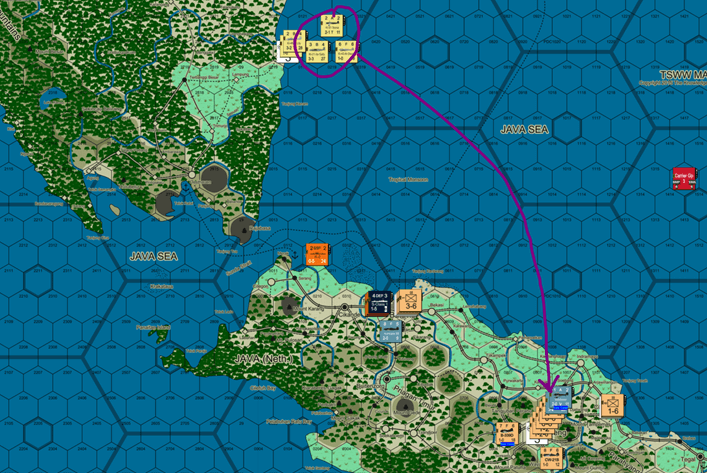
The Allies intercept with one Dutch fighter wing:
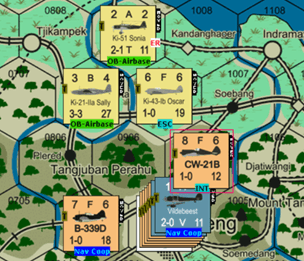
Dutch elect to engage the escorts (as a return near certain if they try to bypass). Dutch fire on 2 column (8 attack v 6 defense) with a -1 (2 Japanese Army ACEV; 1 Dutch). A modified 7 reduces the Oscar wing. It fires back on the 0 column (+1). Just a return. Dutch draw first blood. AA fire is 3 (2 light AA IIs; 1 for city). +1 for NTM and +1 to the B (only). Modified rolls of 6 and 4 produce no effect. Total OBFs dropped are 3 (Sally) and 2*1.5/2 for the Code T Sonia, or 4.5 total. This produces 1 hit and a 50% chance of another, which is achieved. This randomly eliminates 2 ARPs on the ground. Japan misses the Vildebeats; 2 level bomber steps are eliminated. 2 airbase hits also achieved.
Allies launch USAAF LRBs against the Japanese naval-air base in Borneo, some 40 hexes away from their base in Soerabaja. This is mostly to induce the Zeros to fly (Japan has little fighter cover). Japan takes the bait, hoping to dispatch the LB30Bs:
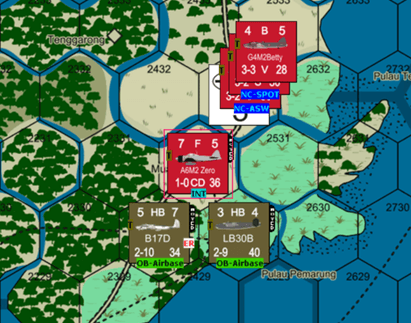
Because the Allies lack fighter escort, Japan gains a +2 DRM for fighter ratio (see 11.C.2). This offsets the -1 for relative ACEV (2 for USAAF; 1 for IJN) and -1 for a 2:1 ratio of B/HB units to the interceptor (see 11.C.4.d.i). The roll is a 10, and the entire LB30B wing is eliminated.
Tora Tora Tora. The US fires back on the -2 column but with the following DRMs: +1 for relative ACEV; +1 for bomber ratio (the B17Ds in effect contribute to fire). The modified 7 is just a return, and doesn’t hurt the Zero. The B17D then bombs the base (there is no flak). It is just 1 net OBF given the range. The 33% of a hit succeeds! A Betty squadron is eliminated. The US thinks it was worth it to take the Zeros off the board. Air losses thus far are 2 squadrons for Japan and 5 for the Allies.
Naval Search missions are next. No air units fly to actual SZs, but a number spot from base. Chiyoda‘s Pete Floatplanes spot from Tanjung Puting; the PBYs from Soerabaja; and the Catalinas from Tjilatjap. These missions can be long range (the only impact of searching from base at long range is on ASW bombing, if any occurs; units searching from base can only bomb subs, and only if Code A). Long-range, for instance, is needed for the Petes. This shows their normal range:
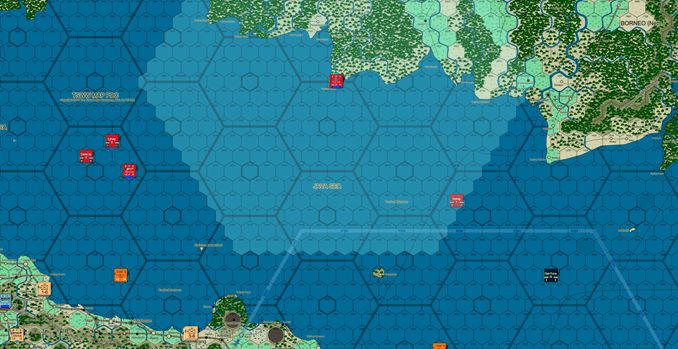
Japanese Naval Movement Step. Japan then sets up for the long-planned amphibious assault (which must occur in the first NMS of their player turn; which is why no landing last NMS). Numerous ships are assigned to AGS which will last only this turn (more on this later).
The Eastern TFs move to land at Cirebon and Tegal. The Allies search before any of the NTFs move (with clear weather). The US Search DRM of +1 (weather/NEM/Wing size) is reduced by the CAP to +0. See 8.K.4.c. Rolls of 7/10 nonetheless spot both the Carrier TF and the landing force. The Allies would like to launch an airstrike; but it would be at extended range; so they wait. In the meantime, the Japanese TFs are once again in the Patrol Zone of the Dutch Sub, which will go after the detected warships spilling over with troops. First, Japan conducts ASW (costs 1 SMA). This requires a successful search. Japan succeeds (7 rolled; +1 NEM, even before DD benefits). Japan has 9 ASW points (12 DDs; a DEF; each ship is 0.5 points and DEF is 6 ships). This is not enough to confer a DRM, but Japan rolls @ +2 for NEM difference. A net roll of 10 drives off the Dutch sub before it can attack and reduces it; the Japanese force move a sea zone and at that point the Allies declare an airstrike by the Vildebeast, escorted by Dutch fighters; with a roll of 9, the force finds the ships . . . .
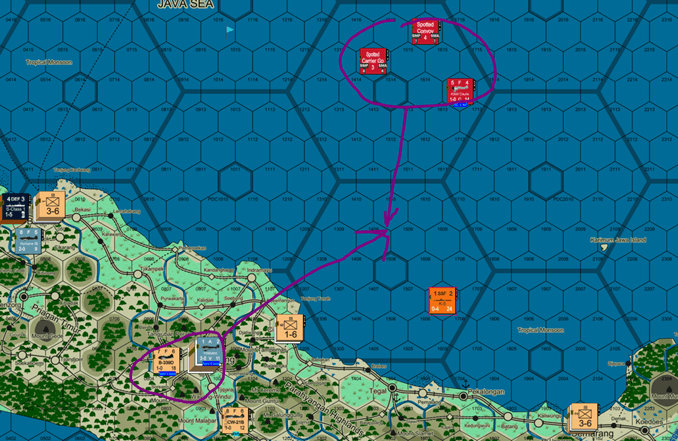
The Ryujo‘s CAP can engage. It can (and does) separate its Claude wing into 2 squadrons (CAP, Air Cover, and Interception can do this; missions cannot once launched; see 8.B.1). Japan concludes that trying to stop the Allied bombers more important than the survival of the Claudes:
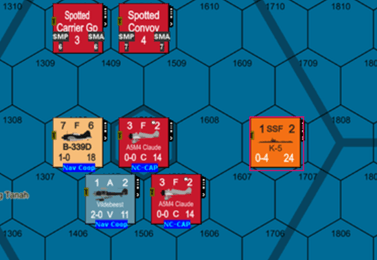
The Dutch fighters could try to avoid the Claudes and go after the Bomber destroyers; but even on the -3 column, there is a better than even chance of an R result @ +3 (which the Claudes would enjoy if the escorts try to ignore the interceptors). So the Dutch engage the fighters screening it, on the 5 column (no DRM). Dutch roll at 4 (killing the Claude squadron); the Claudes cannot hurt the Dutch on the -3 column. However, the Claudes intercepting the Vildebeast roll a 10, a “1” result on the +2 column, flipping the unit. Return fire on the -1 column achieves nothing, and thus the 2d Claude Squadron still is on CAP (an R would have sent it back to the carrier).
The remaining British Torpedo bombers brave AA fire. Japan has 18 amassed. The only DRM is +1 for NEM. Hoping to survive, the Allies had declined to declare a Determined Bombing Mission (such missions have AA doubled but ignore dispersal). Unfortunately, Japan rolls a modified 11. The torpedo bombers are shot down, though ½ the squadron drops its bombs; but because DBA was declined, ½ are dispersed. This leaves a 25% chance of 1 torpedo strike, which fails to hit anything.
The Dutch Dorniers, flying a separate mission, then find the fleet. They go up against the Claudes without escort:
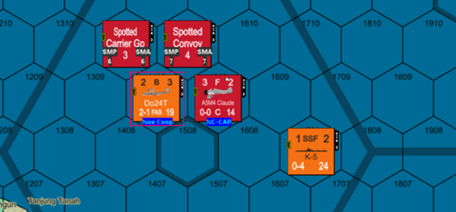
Japan fires with +2 (fighter ratio) and another +2 (ACEV/NEM) on the 0 column. An R result is achieved. The Dutch achieve the same result, which forces the CAP to land. The R result on the Dutch means only 0.25 of the payload gets through, which is a 50% chance of a strike (normally 2 strikes for a wing; so .25×2 = 50% chance of one). But first it must brave the same AA fire as before. A 10 flips the unit and disperses 50% of the remaining payload. The small strike chance (12.5%), however, succeeds. A troop-carrying CL is targeted, with the Dutch ACEV and Japanese NEM cancelling out but the code S Dutch float planes giving a +1. A roll of 3 misses, and the damaged floatplanes return to base.
With air attacks ineffective, the last Allied card is the small flotilla in Batavia (DDs, DEFs, GBs). As within 3 Sea Zones at a Naval Base, interception could be attempted. But against the Japanese Cruisers with their long lances, intervention would be suicidal — they wouldn’t get close enough to engage the transports unless a night actions. So the Allies conserve force.
With that decision, the Western TF divides into its Cirebon and Tegal components. One regiment, on a CA with 5 DDs (one carrying a Mountain XX) and 2xLCs, heads for Tegal. The remainder plan to land at Babakan, adjacent to Cirebon. At Tegal, before landing (see 9.K.4), the CL transfers the regiment it is ferrying to the 2xLCs (each LC can carry 0.5 SP) carried by NSPs; this costs the LCs/NSPs 2 SMPs (not an issue, as the TF started so close to Java) and the Light Infantry III 2MPs. The Mountain II forms a floating reserve, and can land in the Pursuit phase:
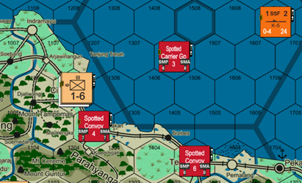
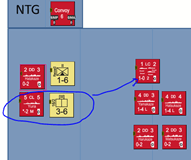
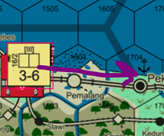
The 3-6 Light Infantry III lands unopposed, taking possession of Tegal. It has spent 4 MPs (2 to transfer to the LC; 2 to land). It has 2 MPs left, and with them marches along the road to Pekalongan harbor. Just like that, Japan has 2 small ports on Java. [note: the last naval-air Allied air, the A-24s, are too far away to effectively strike].
At Cirebon, 2 Light Infantry IIIs transfer to LCs; they and supply (on LCs moving on their own, we will get back to their SMA spend later) will land on the breach and attack Cirebon. The Tanks/AA IIs form a floating reserve.
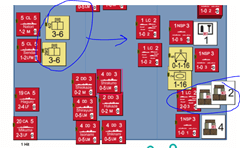
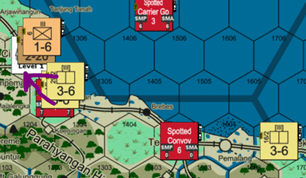
The heavy elements (CAs/CLs) of the Western TF are in position to provide Amphibious Gunnery Support (AGS) in the upcoming combat phase. They have spent less than ⅓ of the SMPs moving to the Assault Zone (only 3; see Rule 13.Q.1.b.).
Moving to the Eastern Sector, the Japanese first search for the remnants of the Allied fleet, using long-range Petes from Chiyoda. But a 3 fails.
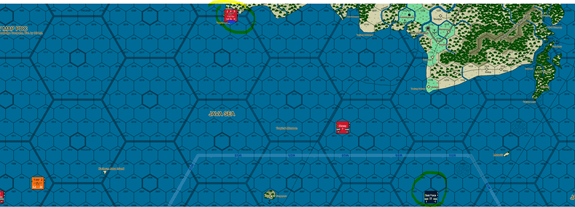
So the reinforcing Japanese TF (2 CAs, CL, 5xDDs) sets out to hunt for the ABDA remnants. This occurs simultaneously, while the Eastern TF heads for the North Coast of Java . . . .
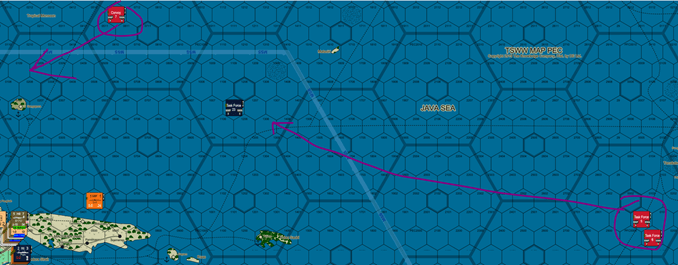
First, the Allied PBYs/Catalinas search for Convoy 7. But both air fail on rolls of 1 and 2. The Allied TF, not being in “extended” search, cannot spot the Convoy. So it moves toward the Java coast undetected. . . . Meanwhile, the Japanese TFs combine into one, and move toward the Allied Fleet, 4 SZs away. The TF is spotted by the Catalinas, but the Allies do not launch planes — the A-24s are saved in case the invasion force is spotted by Coast Watchers. The Coast Watchers, however, fail to spot the invasion on a roll of 2. The Invasion will land undetected. Thus, the Allied A24s turn on Japanese TF6, which they find on a roll of 9. There is no Japanese air cover . . .
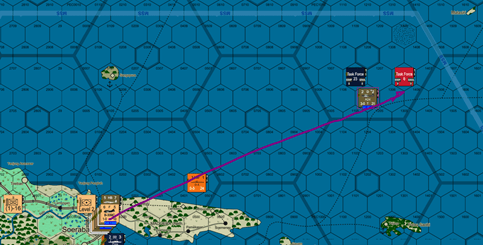
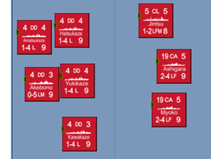
Japanese AA is 9, +1 for NEM. The roll is a modified 3, which completely misses. The A24s go after CA Myoko, with 4 strikes @ +3 (ACEV/NEM difference and +2 for Type D). (percentile roll for a 5th missed). This is where the missing Zeros are really felt (remember the Allied LB30/B-17 raid?). 2 hits with a critical hit. Moyoko is sunk. The Japanese TF’s search for the Allied fleet also fails, with a roll of 4 (+1 for NEM +1 for floatplanes). Having failed to find the Allied fleet (the Allies don’t try to intercept), the reduced Japanese cruiser force joins the landing force off Semerang. Having spent more than ⅓ of its SMPs (10 of 21), it cannot provide AGS; but it can seek to suppress Semerang’s 1 point of CDs:
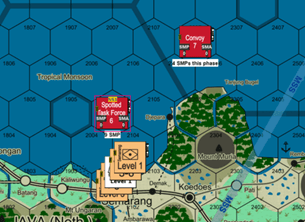
First, the CD gets to fire (4.A.3). Strength is double the CD level (so, here, 2). That is insufficient to hit anything with the -2 DRM for relative NEM (CD uses naval NEM, per the HP “At Start” example of play). Using the naval bombardment procedure (see 4.A.3.b) the Japanese fire back. The CA and CL have float planes, so the 8 Japanese ships have their gunnery divided by 6, not 8. This yields 7.333 factors (the loss of one CA and hit on the other greatly reduce Japanese fire power). 4 factors achieve a hit, and percentile dice give the Japanese 2 here. That reduces the CDs from 1 to 0. The way is now safe for still undetected Convoy 7, which enters the SZ around Semarang [NB: The CD wouldn’t fire at the undetected Convoy until after landing anyway, and John has ruled CD fire is same-hex, only; but suppressing the CD/reduces its fort effect for ground combat, John has ruled].
The Eastern Convoy, having moved 4 SZs, transfers 3 Mountain regiments into 6 LCs. The force intends to land adjacent Semarang. 3 of the LCs had moved on their own power, so fuel is an issue for them. Each LC has an SMA of 7, so 28 for “normal” range. To get to the beach, those 3 LCs had spent 17 SMA total (4 to get ot starting position, 9 last turn, 4 this turn). Still some gas left in the tank, but not much. All ships in the Convoy, having moved less than ⅓ of the Convoy’s SMP (14) can provide AGS (had this not been the case, the faster ships would have broken off into a fast NTG). The Japanese are set up to attack:
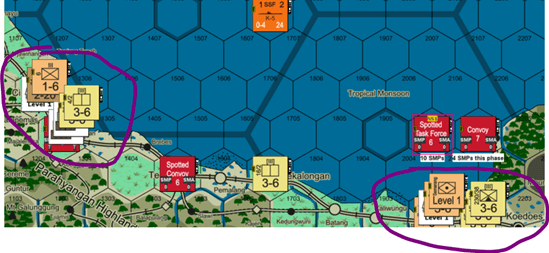
Allied Naval Movement: With the invasions ashroe and forces well-protected, the Allied fleet will not intervene, but rather attempts to return to Soerabaja. Chiyoda‘s Petes can try to spot again and succeed on a 9. This leads to an onslaught on the ABDA naval force by Japanese naval air (an Allied attempt at air cover failed on a roll of 1).
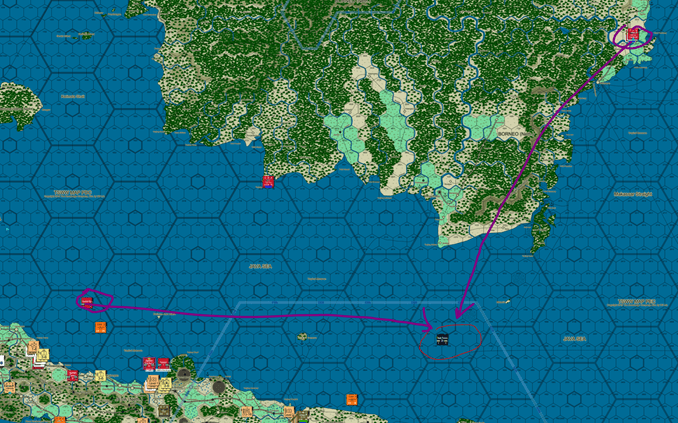
First, Kates from Ryujo find the Allied ships. Allied AA is a measly 4, but with the Western Allied element dominant. So net roll is +3 (NEM/NTM; no mod for Type A). A modified 11 results in an R, reducing the Japanese attack by 25%. The Kate Squadron normally would have a Torpedo factor of 3, but that is reduced 25%; the resulting 2 strikes aim at Hobart with no DRM (NEMs the same). 1 strike is achieved, which causes no damage (roll of 3; need a 5 to inflict damage). One wing of Code S Bettys also finds the Allied fleet. AA causes another R result, reducing the effectiveness to 2 strikes from 3. Each is +1 for the Code S. Hobart is hit (now 2 hits). The ABDA force limps into port at Soerabaja. The small force at Batavia transfers to Tijtljajp.
That is it for the ships; but the A-24s can fly in two NMS in a player turn, and now try to find the Japanese fleet. But on a roll of 3, they get lost in the fog.
Rest of Movement Phase. Japanese ground forces have moved as part of amphibious assault, so remaining activities in the movement phase are non-CAS bombing, if any. There is none.
Combat Phase. Japan declares attacks against Cirebon and Semarang. Next, CAS missions are declared, starting with the Phasing Player, Japan.
Japan sends a CAS mission to Cirebon from Sumatra. Long range Nates (exactly 18 hexes) escorting Lilys. Hurricanes from Batavia area and P40Es from south of Semarang intercept (allies hold back a P-40 squadron anticipating more action). Allies hope to shred the bombers. First, the escort engages the interceptors. ACEV is even, but the Allies have a +1 for fighter ratio. Japan attack rating is cut to 3 because of range. US rolls a 10, flipping the Nate unit. It returns fire with a 6, no effect on the P-40s. The Hurris then attack the Lillys, also @ +1 but on the 4 column. A modified 6 flips the Lilly unit, which rolls a 1 on return fire, missing the Brits. The 1 factor of AA (firing +3) achieves no effect. The Code T Lilly will add 2 factors here.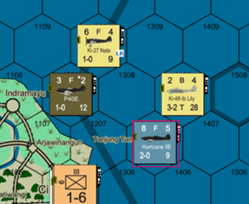
Japan sends Long-range IJN Betties (flying a non-naval missions, as is permitted) to Semarang. The remaining P-40s intercept. As there is no escort, they have a +2 fighter ratio and +1 for ACEV. An “R” is achieved against no loss. AA inflicts another R result (3 factors with +3, 9 rolled). So the bombers will have virtually no effect (0.09 factors added).
The Allies also send CAS, which Japan lacks fighters to intercept. The Allies’ objective is to attain superiority in squadrons for the Combat DRM (See 5.B.6). The ships cannot fire AA. The combat strength added is nominal (0.5 in both cases); it is the DRM that counts. Japan, however, can counter with naval gunfire …… On to combat resolution:
Cirebon. Defense strength is 1.5 for the Dutch, which includes 0.5 from Organic AA for the small city (CEV of 1) and 2.6 for the British II (CEV of 1.3 x 2). Total defense strength, with air, of 4.6. For Japan, two light infantry regiments are attacking. Before terrain each is 3 x 2 (CEV), or a total of 12. The peddy terrain and small city and level 1 fort all have no effect (1 multiplier in all cases).
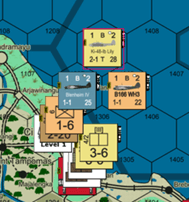
Japan then adds gunnery and air. Air, as noted, was 2 (thus now 14). 1 CA, 1 CL, and 4xDD are held back from AGS (so as to deter the Allied fleet). The remaining force has gunnery of 43. This is normally divided by 2, but two of the Japanese units have floatplanes, which allows firing at face value, making the modified strength is 57 (!). Obviously the attack will be 9:1. Initial DRM is -4. The Allies attain -2 for air (more fighters, more bombers on CAS, but not quite theatre fighter superiority, as 2:1 needed and the Allies have 10 squadrons to 6); the level 1 fort is an additional -1 as is the city. Amphibious invasions may roll for surprise, with no penalty for failure. The roll needed is a 6, and a 10 is rolled, so final DRM is -2. Japan rolls a 5 which becomes a 3. DH result. The Dutch regiment is eliminated and British AA II retreats. Japan advances 1 regiment.
At Semarang, defense is 4 (air/ground/value of organic AA (0.5 per point)). The attacking Japanese are 9x2x.75 (major city)+air for 13.6. But once again, AGS is potent. Japan can add 27, while holding back several ship. Japan has easily enough to get 9:1 odds. The DRM is -6 (City is -2, air -2, CD/Level 1 fieldwork -2); but surprise is again achieved, so net is -4. A fortunate 9 becomes a 5. DE. The Dutch defenders are eliminated. Japan needs air superiority, badly . . . One regiment advances.